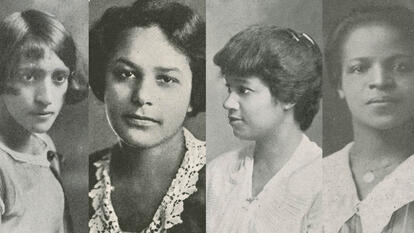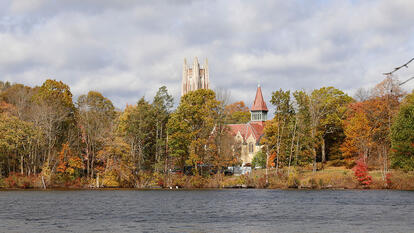“Boston’s Hidden Sacred Spaces” Photo Exhibition at Jewett Offers Rare Glimpse into Area Buildings

Across Greater Boston, chapels, meditation rooms, and prayer rooms invite passers-by to stop and reflect as they make their way through secular institutions such as hospitals, retirement communities, and prisons. The Wellesley community can now view some of these tucked-away retreats (pictured above) thanks to Boston’s Hidden Sacred Spaces, a photo exhibition on display through December 1 in the Sculpture Court of the Jewett Arts Center.
The project, which includes a website with images, detailed location maps, and short descriptions of the sites, is a collaboration among Alice Friedman, Grace Slack McNeil Professor of the History of American Art at Wellesley and co-director of the College’s architecture program; Wendy Cadge, professor of sociology at Brandeis University; and Randall Armor, a Boston-based photographer and educator, who took pictures of more than 60 spaces.
“I’m excited by the truly interdisciplinary nature of this exhibition,” said Samara Pearlstein, gallery director of the Art Department. “Each collaborator brought a particular base of knowledge to the work, which means we aren’t just getting the photographer’s-eye view of these spaces (although we are definitely getting that!); we are seeing spaces that have been chosen for their wide variety of architectural and sociological impact.”
Many of the locales reflect the region’s history, as with cemetery chapels constructed in the 1800s and early 1930s, and port and workmen’s chapels built in the 1950s and 1960s. Others spaces are housed in schools and universities (including Wellesley’s Houghton Chapel), military installations, malls, and even the Isabella Stewart Gardner Museum.
What makes a space “sacred” differs significantly from person to person and group to group, and a sacred place in an airport is different from a sacred place in a hospital, noted Pearlstein, and that’s reflected in the work.
“What is similar about all these hidden sacred spaces is this sense of a place where the usual business of the institution can be set aside for a quieter form of contemplation, whether that takes the form of religious worship or meditation or whatever,” Pearlstein said. “You get to see some very different forms of architecture, some very different approaches to this idea of a sacred space, but each in its own way evokes that sense of retreat or refuge.”
Friedman agrees: “All of the spaces are interesting in one way or another. Many are unfamiliar or surprising—like Our Lady of the Airways at Logan Airport or the full-scale Catholic chapel in the Prudential Center, right next to Dunkin’ Donuts—and many are very beautiful, architect-designed places.”
The exhibition has traveled to many local venues, including churches, cafés, Boston City Hall, and the John Joseph Moakley Federal Courthouse. Friedman is delighted to have it at Wellesley. “Many students, staff, and faculty are fascinated by the varieties of spiritual life and curious about the value and meaning of place-based experience,” she said.
Zhengyang Echo Yue ’14, who recently earned a master’s degree in architecture from Columbia University, attended the November 9 opening reception for the exhibition. “What struck me the most was the location of the sacred spaces,” she said. “Before the exhibition I had no idea places like airports had them.”
She continued: “I have always believed that good architecture tries to give back to the public as much as possible. The recorded sacred spaces for the public to pray, to meditate, or just to be with themselves are vital.”



